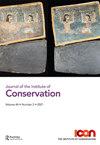根据新策略修复两处历史悠久的皮革装订处
IF 1
0 HUMANITIES, MULTIDISCIPLINARY
引用次数: 6
摘要
摘要当前的研究提出了一种处理降解历史皮革的新策略。使用数字显微镜、pH、FTIR和SEM分析来评估两种可追溯到14世纪的皮革装订的降解情况。根据皮革保护领域的新配方,执行了一个保护过程,包括清洁和填充孔洞,该配方包含皮革粉末、无水纤维素、纤维素粉末、阿拉伯树胶、明胶粉末和粘土纳米颗粒。在现代皮革样品加速老化前后,通过监测其pH值和颜色的任何变化,以及在将填料应用于历史皮革之前的差热分析,对新配方进行了评估。结果表明,皮革的酸度保持在其自然状态,并且皮革没有表现出任何氧化和水解。此外,新配方的评估过程表明,它可能是一种很有前途的填补皮革损失的材料,尤其是因为它具有热稳定性,并且与皮革的酸度一致。此外,新的填充材料易于操作,不会出现明显的收缩或颜色变化。本文章由计算机程序翻译,如有差异,请以英文原文为准。
The restoration of two historic leather bindings according to a new strategy
Abstract The current research presents a new strategy for the treatment of degraded historical leather. Digital microscope, pH, FTIR and SEM analyses were used to evaluate the degradation of two leather bookbindings dated back to the fourteenth century. A conservation process was executed and included cleaning and the filling of holes according to a new recipe in the field of leather conservation containing leather powder, anhydrous cellulose, cellulose powder, acacia arabica, gelatin powder and clay nanoparticles. The new recipe was evaluated on modern leather samples before and after their accelerated ageing by monitoring any changes in their pH and colour, along with differential thermal analysis before the filler was applied to the historic leather. Results showed that the acidity of the leather remained in its natural state and the leather did not exhibit any oxidation nor hydrolysis. Moreover, the evaluation process for the new recipe suggested that it could be a promising material for the filling of losses to leather especially as it is thermally stable and shows consistency with the acidity of leather. Furthermore, the new fill material is easy to manipulate and shows no significant shrinkage or change to its colour.
求助全文
通过发布文献求助,成功后即可免费获取论文全文。
去求助
来源期刊

Journal of the Institute of Conservation
HUMANITIES, MULTIDISCIPLINARY-
CiteScore
1.50
自引率
0.00%
发文量
22
期刊介绍:
The Journal of the Institute of Conservation is the peer reviewed publication of the Institute of Conservation (Icon). As such, its aims reflect those of Icon, to advance knowledge and education in conservation and achieve the long term preservation and conservation of moveable and immoveable cultural heritage. The Journal provides a collective identity for conservators; it promotes and supports both the profession and professionalism. With international contributions on all aspects of conservation, it is an invaluable resource for the heritage sector. The specific aims of the Journal are to: 1. promote research, knowledge and understanding of cultural heritage conservation through its history, practice and theory 2. provide an international forum to enable and disseminate advances in research, knowledge and understanding relating to conservation and heritage 3. champion and support professional standards of heritage conservation in the UK and internationally 4. provide a permanent record of issues relating to conservation and heritage 5. be financially and operationally sustainable. To achieve these aims, the Journal invites contributions from all those involved in the conservation of cultural heritage and related activities. Areas of interest include understanding cultural heritage materials and their degradation; subject reviews and histories of cultural heritage materials and conservation treatments; new, innovative or improved approaches to conservation and collections care theory, practice, communication, management and training; case studies demonstrating new, innovative or improved approaches; and conservation in its wider context. Submitters are encouraged to demonstrate how their work is of practical application to conservation. To maintain professional standards and promote academic rigour, submissions of articles and shorter notices are subject to an anonymous peer review process.
 求助内容:
求助内容: 应助结果提醒方式:
应助结果提醒方式:


